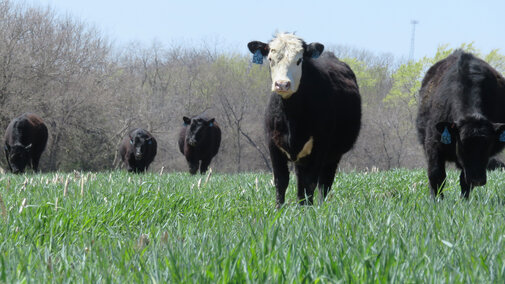Additional Resources:
- For more information about nitrates in forages and reducing risk of toxicity see the NebGuide: Nitrates in Livestock Feeding.
- Considerations for Forage Cover Crops after Hail in Corn and Soybean.
Planting cover crops after severe wind or hail damage to crops is becoming increasingly common. Often growers are planting species that have been used as forages for many years with the thought that they may be grazed.
If these cover crops are to be grazed, growers need to consider that many of these species have the potential to accumulate high levels of nitrates. The specific level at which nitrates become risky to cattle is unknown; however, with careful grazing, haying, and livestock management the potential for livestock losses can be reduced.
The potential for high nitrate concentrations is more of a concern with haying than with grazing. All annual grasses and brassicas can accumulate nitrate. The brassicas accumulate more than grasses, but they are also higher energy. This may help offset some of the toxicity concerns. We have grazed some very high nitrate fields with no issues.
Haying is a different story. Currently recommended levels of risk are based on hay feeding. Levels above 2100 ppm of N03-N are considered high risk, which is appropriate. The potential for nitrate toxicity is lower in grazed forages than in hay with the same level of nitrate due to the following factors:
- Grazing animals eat more gradually than those receiving hay.
- When cattle are grazing, they tend to be selective and do not graze the entire field close to the ground (where nitrate is highest). This means that if allowed access to the field (not strip grazed), they will likely consume the plant parts with lower nitrate concentration first. This will reduce the amount of nitrates consumed during the grazing period.
- Fresh (high-moisture) forages release nitrates into the rumen at a slower rate than dry forages such as hay.
- Cattle consuming high-energy diets can handle more nitrates than those on low-energy diets. Many of the cover crops grazed are very high energy, including the brassicas and immature grasses.
It should be noted that allowing a warm-season summer annual to reach maturity and stockpiling it for winter grazing will reduce nitrate toxicity susceptibility. Although toxicity concerns will be less than with hay since the animal can be selective and intake will be slower, the buffer of high moisture or high energy is reduced.
During the past few years we have grazed calves on fall cover crops. When analyzed for nitrates, many of these would be considered extremely high risk (see Table 1). However, no signs of toxicity were noted and calves gained 1.3 to 2.2 lb/day (low rate of gain was in 2015 with extended cold/wet weather). In all instances, calves were allowed to be selective (access to the whole field at once; 60 days of grazing). Forage quality was very high (above 65% TDN).
To summarize, nitrate toxicity will always be a concern when planting cover crops for forage in hail-damaged crop fields. Grazing cover crops with elevated nitrate concentrations does have some risk, which can be reduced with careful management.
| Forage | N03-N, ppm | Animal | Year |
|---|---|---|---|
| oat, turnip, radish | 6146 | steers | 2014 |
| oat, turnip, radish | 4655 | steers | 2015 |
| oat, turnip, radish | 2158 | heifers | 2015 |
| oats (south paddock) | 912 | steers | 2015 |
| oats (north paddock) | 4414 | steers | 2015 |
| oats (north paddock) | 3921 | steers | 2016 |
| oats (south paddock) | 8026 | steers | 2016 |
Management Strategies to Mitigate Nitrate Toxicity
Make sure cattle are full before putting them on fields. Regardless of the nitrate level, a good management practice is to fill cattle up with hay before turn-out.
Use lower risk cattle, if possible. The group with the greatest risk of negative consequences due to feeding on high-nitrate forages is pregnant cows, as abortion can result. Open cows are the best option followed by growing calves (stockers or developing replacement heifers before breeding).
Gradual adaptation is a key management strategy to minimize risk when using high nitrate forages. Losses from nitrate toxicity will be much greater in cattle not adapted to nitrate. The bacteria in the rumen capable of degrading nitrite to ammonia for bacterial protein synthesis will increase when nitrate is available to them. Adapted animals can safely be fed higher levels. To adapt the cattle, start by grazing the lowest-nitrate fields and then work up to the highest.
Graze higher N fields lightly to allow animals to selectively graze plant parts that are lower in nitrate concentration. Nitrate level varies with location in the plant. Nitrate tends to accumulate in the lower stem, so overgrazing so that cattle have to eat the lower stem can cause an increased intake of nitrate.
Consider grain supplementation while adapting cattle to high-nitrate, lower quality forages such as mature sorghum x sudangrass hybrids or pearl millet. This will supply energy for rumen microbes to convert nitrate into bacterial protein and minimizes the intermediate nitrite production. Brassicas, such as turnips and radishes, are highly digestible and as such may provide enough energy to allow for increased microbial protein synthesis. Grain feeding may be of limited benefit for high quality cover crops.
Ultimately, the decision to graze high nitrate fields is a judgment call and a question of how much risk a producer is willing to take.

